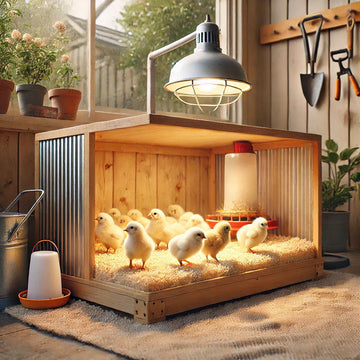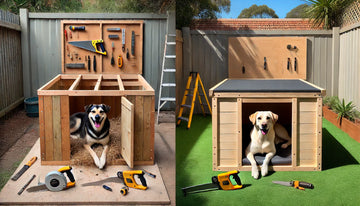👋 Introduction
Raising baby chicks is adorable—but it's also a big responsibility. Without proper warmth, space, and protection, even a few hours can make the difference between healthy birds and disaster. A well-planned chicken brooder is your chicks’ first home—and it needs to be just right.
In this visual guide, we’ll walk you through:
-
✅ What a brooder is and why it matters
-
🛠️ How to build a DIY brooder
-
🪵 The best bedding for chick comfort
-
🌡️ Temperature tips
-
🐣 Mistakes to avoid
-
🔎 PLUS: ready-made brooders perfect for Aussie conditions!
📦 What Is a Chicken Brooder?
“Think of a brooder as your chicks’ warm, safe nursery for the first 6–8 weeks.”
🔍 Definition & Purpose
A brooder is an enclosed setup that mimics the warmth and protection of a mother hen. It includes:
-
A warm heat source (like a lamp or plate)
-
Protective walls or a container
-
Bedding and hygiene setup
-
Access to water and chick feed

🧰 What You Need to Build a Chick Brooder
🛒 Brooder Essentials Checklist
![]()
| Item | Purpose |
|---|---|
| ✅ Container (tub, crate, box) | Enclosure for chicks |
| 🔥 Heat lamp or brooder plate | Keeps chicks warm |
| 🪵 Bedding | Comfort & hygiene |
| 💧 Waterer | Hydration without drowning risk |
| 🍽️ Feeder | Accessible chick-sized food station |
💡 Pro Tip: Choose a box at least 30–40cm high to prevent chicks from jumping out as they grow bolder.
🔨 DIY Chicken Brooder Setup (Step-by-Step)
Let’s walk you through a chick-safe brooder setup. You’ll only need an hour max to assemble everything.
🔧 Step 1: Choose Your Brooder Box
You can use:
-
Plastic storage tubs
-
Plywood or wooden crates
-
Old drawers or repurposed furniture
-
Large cardboard boxes (short-term use)

🌬️ Step 2: Add Proper Ventilation
Drill small holes near the top of the brooder OR use a mesh lid for airflow. Poor ventilation = respiratory issues.
🔥 Step 3: Install the Heat Source
Choose one:
-
Heat Lamp (infrared, clamped above one side)
-
Brooder Plate (low-risk, chicks cuddle underneath)
🧯 Safety Reminder: Secure lamps with chains or clamps and never place near flammable bedding.
🪵 Step 4: Lay Down the Right Bedding
Best bedding options:
-
✔️ Pine shavings (absorbent + odor control)
-
✔️ Paper towels (great for first few days)
-
❌ Avoid: Cedar (toxic oils), slippery newspaper, cat litter
🥛 Step 5: Set Up Food & Water
Use chick-safe:
-
Waterers with shallow trays
-
Mini feeders to prevent tipping
-
Place away from heat to avoid spoilage
📊 Brooder Box Temperature Guide
| Week | Temp Needed |
|---|---|
| 1 | 35°C |
| 2 | 32°C |
| 3 | 29°C |
| 4 | 26°C |
| 5 | 23°C |
🧠 Observe: Chicks huddling = too cold. Panting = too hot. Calm and scattered = perfect.
🚫 Common Brooder Mistakes to Avoid
-
❌ Overcrowding (causes stress + feather pecking)
-
❌ Poor airflow (leads to illness)
-
❌ Ignoring cleaning (increases bacteria)
-
❌ Using slippery bedding (can harm feet)

🧳 When to Move Chicks Out of the Brooder
Your chicks are ready for the coop when:
-
✔️ Fully feathered (5–8 weeks)
-
✔️ Day temps above 20°C
-
✔️ Eating/drinking independently
-
✔️ Exploring confidently
🌦️ Transition Tip: Let them explore the coop during warm midday hours before moving them full-time.
📦 Explore Our Ready-to-Use Brooder Solutions
Skip the setup stress and go with a professionally designed, Aussie-ready brooder box.
✅ Built for safety
✅ Ideal for indoor or patio use
✅ Includes lighting, mesh covers, and spill-resistant trays
🔘 👉 Explore our range of ready-to-use chicken brooder boxes here.
❓FAQs
How do I build a chick brooder at home?
Use a secure box with a heat source, clean bedding, and safe water/food stations. Include ventilation and temperature control. DIY with tubs or crates.
What’s the best bedding for a brooder box?
Pine shavings are soft, absorbent, and chick-safe. Paper towels are great for the first few days.
How warm should a chick brooder be?
Start at 35°C and reduce by 2.5–3°C each week. Monitor with a thermometer and chick behavior.
Can I keep the brooder outside?
Yes, if it's sheltered, insulated, and safe from predators. Maintain consistent temps.
When can chicks leave the brooder?
When they are fully feathered and can regulate their body temp—usually around 5–8 weeks.





